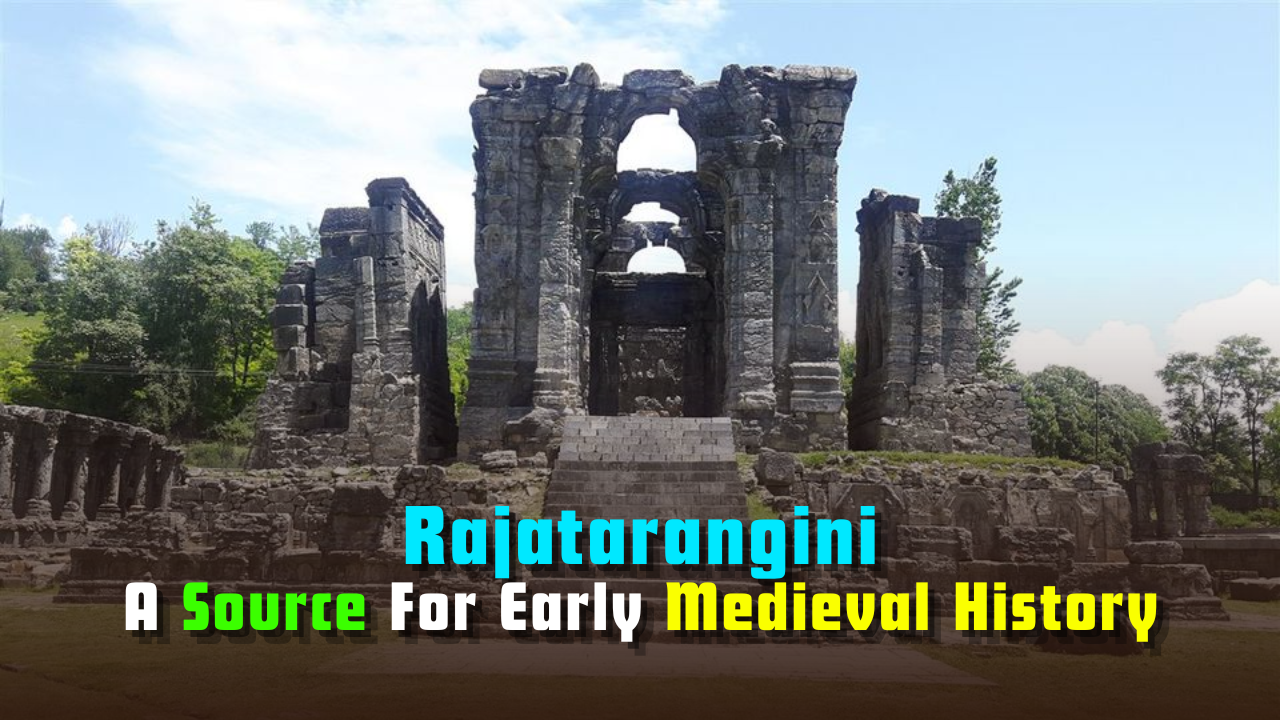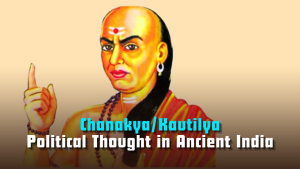Rajatarangini: A Source for Early Medieval History
Explore Kalhana’s Rajatarangini, a 12th-century Sanskrit chronicle that offers a detailed historical and literary account of Kashmir’s dynasties, kings, and cultural legacy.
The Rajatarangini is a historical chronicle of the 12th century where the writer is Kalhana. The Rajatarangini is important in the UPSC syllabus, mainly in the History Optional paper. Its documentation of the medieval history of Kashmir is extensive, covering the reigns of various dynasties, kings, and other main historical events

Introduction: Rajatarangini
The Rajatarangini, literally meaning “River of Kings,” is one of the most significant historical chronicles from early medieval India. Composed in the 12th century CE by Kalhana, a Kashmiri Brahmin, the work offers an expansive and continuous historical record of Kashmir. While technically a Sanskrit mahākāvya, or poetic epic, the Rajatarangini holds immense value for historians due to its detailed documentation of dynasties, political transitions, and regional developments. It remains particularly relevant for UPSC aspirants studying early medieval India, especially those with History as an optional subject.

About the Author and Composition
Kalhana, the author of the Rajatarangini, is believed to have lived during the reign of King Jayasimha of Kashmir (r. 1128–1155 CE). He was the son of Champaka, a minister in the court of King Harsha (r. 1089–1101 CE), though there is no strong evidence to suggest Kalhana held a courtly position himself. Writing around 1148–1150 CE, Kalhana sought to provide a comprehensive and methodical account of Kashmir’s rulers, blending mythology, oral traditions, earlier written records, and his own observations.
The Rajatarangini is roughly 8,000 verses and is presented in eight books of drastically different lengths, which document the ascendance and decline of Kashmir’s royal families – from a mythic origins story to the author’s contemporary moment. The poem, in effect, recounts more than two thousand years of Kashmir’s ancient and early medieval history, providing an expansive narrative about the region’s political development.
Historical Method and Literary Approach
1. Self-Reflexive Approach
- Kalhana opens the Rajatarangini with a clear prolegomenon (introduction), stating:
- Purpose (Prayojana) – The objective of writing history.
- Method (Upaya) – The technique or approach to historical analysis.
- Philosophy (Adhyasa) – The underlying perspective guiding the historical narrative.
- This reveals Kalhana’s awareness of the process and responsibility of historical writing.
2. Conscious Continuation of Earlier Historiography
- Kalhana acknowledged that he was not the first historian of Kashmir.
- He referenced at least eleven earlier Sanskrit historical works.
- Of these, only the Nilamata Purana (8th century CE) has survived.
- Another known historian is Kshemendra (11th century CE).
- This reflects a long-standing tradition of premodern historical writing in Kashmir.
3. Use of Diverse Sanskrit Literary Traditions
Kalhana enriched his work by drawing upon various classical Sanskrit forms, including:
- Shastra – Texts on law, statecraft, and political theory.
- Niti – Ethical and political parables or lessons.
- Itihasa – Traditional narratives combining history and legend.
- Vamshavali – Genealogical records of dynasties and rulers.
4. Integration of Kavya and Historical Narrative
- Rajatarangini moves fluidly between:
- Kavya – Poetic and aesthetic literature.
- Historical narrative – A structured and factual recounting of events.
- This fusion of genres creates a unique literary-historical text.
- It is not an anomaly but part of a larger intellectual tradition within Indian historiography.
5. Synthesis Rather Than Exception
- Contrary to the common view of Rajatarangini as a rare exception in Sanskrit historical writing:
- Kalhana’s work synthesised multiple intellectual traditions.
- It did not stand apart but rather drew from and contributed to the broader literary and historical culture of the time.
Structure and Coverage of Dynasties
Kalhana’s narrative begins with the legendary Gonanda dynasty and progresses to historically verifiable dynasties of Kashmir. His use of traditional Indian calendrical systems—such as Kaliyuga and Shaka Samvat—enables relatively accurate chronological reconstruction.
1. Chronological Framework of Kashmir’s History
- Kalhana provides a complete chronological record of Kashmir’s rulers.
- Utilises traditional Indian dating systems, including:
- Kaliyuga
- Shaka Samvat
- Ensures accurate representation of regnal dates across different dynasties.
2. Coverage of Successive Dynasties
The text details the rule of several major dynasties:
- Gonandiyas – 5th to 6th century CE
- Karkotas – 7th to 9th century CE
- Utpalas – 9th century CE
- Loharas – 10th to 12th century CE
- Presents a rare sense of historical continuity across nearly 1,700 years.
3. Inclusion of Prominent Pan-Indian Rulers
Kalhana references historically significant rulers whose influence extended beyond Kashmir:
- Ashoka (Mauryan emperor, 4th century BCE) – Integrated Kashmir into the Mauryan Empire.
- Kanishka (Kushana ruler, 2nd century CE) – Known for his cultural patronage and territorial expansion.
- Toramana and Mihirakula (Huna kings, 6th century CE) – Rulers who brought Kashmir under their empire.
- Their association with Kashmir is evidenced by archaeological finds, including coins in gold, silver, copper, and alloys.
4. Highlighting Powerful Local Kashmiri Monarchs
Kalhana places particular emphasis on native rulers:
- Lalitaditya Muktapida (8th century CE) –
- Known for military conquests across Eastern India and Central Asia (Sinkiang and Iran).
- Avantivarman (9th century CE) –
- Renowned for flood control efforts and infrastructure development.
- Queen Didda (10th century CE) –
- A rare example of female political authority in early Indian history, noted for her administrative strength.
5. Integration into Wider Empires
- Kalhana demonstrates how Kashmir was not isolated, but integrated into larger transregional empires.
- His narrative shows Kashmir as both an independent kingdom and a vital region within broader imperial networks.
Kalhana’s Analytical and Moral Vision
Kalhana’s chronicle is not merely a sequence of events. His narrative is interwoven with moral and ethical reflections, showing concern for dharma (righteous rule) and prajanupālanam (welfare of subjects). He often judges rulers based on their governance, administrative reforms, and attitude towards justice and religion.
Despite claiming neutrality, Kalhana’s subjectivity is visible. He often uses strong or even caustic language when referring to rulers who deviated from dharma. This ethical evaluation of kingship sets the Rajatarangini apart from other contemporaneous Sanskrit works, which typically shied away from explicit criticism of royalty.
His concern for the common people is also noteworthy. The suffering or wellbeing of ordinary subjects is often presented as a barometer of a ruler’s legitimacy, thus embedding an early sense of social accountability within the royal narrative.
Limitations and Historical Usefulness
While Rajatarangini is a rich source, it is not devoid of limitations. The earlier sections rely on myths and legendary genealogies, making them less reliable for strict historical analysis. Furthermore, Kalhana’s accounts are occasionally shaped by poetic exaggeration and moralising tendencies.
However, for the post-7th century CE period, the chronicle becomes increasingly reliable, corroborated by inscriptions, coins, and archaeological evidence. Excavated coin hoards of gold, silver, and copper alloys across the Kashmir Valley align with dynastic shifts described in the text.
Thus, the Rajatarangini is indispensable for understanding:
- Regional polity and succession patterns
- Cultural and religious practices
- Local administration and land grants
- Role of women and queens in governance
- Interactions between Kashmir and Central Asia
Conclusion
Kalhana’s Rajatarangini stands as a singular achievement in Indian historiography. It merges poetry and historical inquiry, aesthetics and ethics, to produce a compelling record of Kashmir’s political and cultural legacy. While not entirely free of bias or myth, it offers an invaluable source for understanding the dynamics of early medieval polity in northern India. For UPSC aspirants, it exemplifies how indigenous traditions of history writing in India were nuanced, reflective, and regionally rich—far beyond the colonial notion that India lacked historical consciousness.
Subscribe to our Youtube Channel for more Valuable Content – TheStudyias
Download the App to Subscribe to our Courses – Thestudyias
The Source’s Authority and Ownership of the Article is Claimed By THE STUDY IAS BY MANIKANT SINGH



